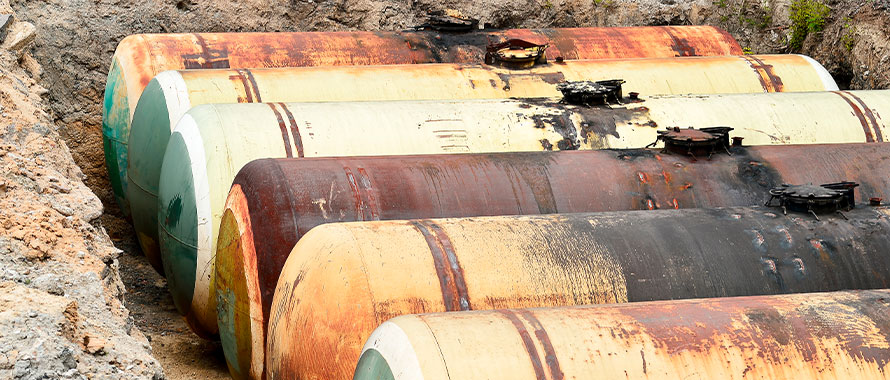Inside This Article:
- Recently released government emails show the massive scale of a December leak from a gas station’s underground storage tank, with an estimated 100,000 liters of diesel fuel released into the environment.
- Groundwater contamination impacted surrounding properties including a Tim Hortons cafe, where customers said they could smell fuel in the bathrooms and even taste it in their drinks.
- Storage tank leaks can lead to millions of dollars in damages and business disruption.
- Cleanup costs, bodily injuries and other expenses could be covered by Storage Tank Pollution Liability Insurance.
- Securing coverage requires implementing a leak detection strategy.
Recently released government emails from the village of Woodstock, New Brunswick, revealed the massive scope of a Dec. 12 leak of an underground storage tank at an Irving Oil gas station. According to CBC News, which obtained the documents, an estimated 100,000 liters of diesel fuel leaked into the environment. The leak, potentially caused by a cracked underground pipe, went undetected for an unknown period of time before a nearby Tim Hortons filed an incident report about petroleum in its untreated water.
The fuel contaminated groundwater and forced the closure of the Tim Hortons, where customers reportedly smelled fuel while washing their hands in the restroom and tasted it in their beverages as early as November. The leak also shut down another neighboring restaurant. Environmental cleanup crews were still working to remediate the spill as of mid-March, as officials continued investigating the leak and why it was not detected sooner.
“This incident was sort of a perfect storm of anything and everything that could go wrong,” said Karim Jaroudi, Manager, Environmental, Burns & Wilcox, Toronto, Ontario. “It is clear to see the economical, environmental and human toll that this could take on the community.”
This incident was sort of a perfect storm of anything and everything that could go wrong. It is clear to see the economical, environmental and human toll that this could take on the community.
Expenses related to this type of leak can be covered by a Storage Tank Pollution Liability Policy, said Beth Linton, Vice President, Environmental Brokerage, Environmental Underwriting Solutions, a division of Burns & Wilcox, Atlanta, Georgia.
“Leaks from underground and above-ground storage tanks are pervasive,” she said. “Any owner of an above-ground or underground storage tank needs Storage Tank Pollution Liability coverage for any tank they may own.”
Leaks from underground and above-ground storage tanks are pervasive. … Any owner of an above-ground or underground storage tank needs Storage Tank Pollution Liability coverage for any tank they may own.
Cleanup, potential injuries among top expenses
According to OHS Canada, the full impact of the recent fuel leak is yet to be identified, as businesses and residents in the area remain affected and water testing for local properties is ongoing. A document obtained by CBC News showed that surface water in highway ditches near the leak contained 90% fuel, and one source told OHS Canada that it was “mind-boggling” that so much fuel could leak undetected.
Between cleanup costs, environmental impacts and possible bodily injuries, the cost of such a significant leak could easily exceed hundreds of thousands to millions of dollars, Linton said. “The cost depends on the amount of fuel released and what the environment is like around it. It could be extremely costly,” she said.
Without Environmental Insurance policies like Storage Tank Pollution Liability Insurance, this type of accident could be disastrous to a company. “I have seen a leaking underground storage tank put a company out of business,” Linton said. “I have seen cases where an owner has a storage tank leak and does not realize they are on the hook for the cleanup costs. Many storage tank owners do not realize how costly it is.”
After a leak, Storage Tank Pollution Liability Insurance can help cover the cost of cleanup, third-party bodily injuries and property damage, legal defense, natural resources damage, and more. It can also respond to leaks caused by the tank’s associated piping, Jaroudi said.
“For many storage tanks, particularly underground tanks, it might not be a matter of if they leak, it might be a matter of when,” he said. “This is a line of coverage that is often inexplicably underestimated,” and many clients only purchase it because they are required to do so by regulatory entities, real estate agreements or other factors.
For many storage tanks – particularly underground tanks – it might not be a matter of if they leak, it might be a matter of when.
Leaks possible ‘even when everything is done right’
Data from the U.S. Environmental Protection Agency shows that about 81 million individuals in the U.S. live within a quarter mile of an underground storage tank that has experienced at least one leak, the Associated Press reported in 2024. Even a “pinprick-sized hole” in an underground tank can lead to 400 gallons of fuel leaking into the ground per year, the report noted. Both the U.S. and Canada have regulations on how storage tanks must be monitored for leaks, but these systems can fail, Jaroudi said.
With the fuel leak in Canada, authorities will be working to determine whether the leak occurred despite robust monitoring. “The answer will likely be on the scale toward yes, which makes even more of an argument for Storage Tank Pollution Liability Insurance or the more robust Site Pollution Insurance,” he said.
Storage tank leak cleanup costs vary, but U.S. data shows the average cost for site cleanup is about $154,000, according to the Associated Press. Companies can purchase Storage Tank Pollution Liability Insurance as a standalone policy or the coverage can be added to a broader Site Pollution Insurance policy or Pollution Legal Liability Insurance policy, Linton explained. “An owner is required to have a leak detection system in place, and it must be tested annually,” she said. “In order to get insurance, you would need to provide the most recent leak detection test.”
An owner is required to have a leak detection system in place, and it must be tested annually. In order to get insurance, you would need to provide the most recent leak detection test.
When individuals’ health is potentially directly affected by a pollution incident, as seen in the recent gas station leak with groundwater being put to immediate use at the Tim Hortons, “it does not get worse in my mind,” Jaroudi noted.
“Besides their own gas station, which obviously had to stop operating, there could be loss of business income for the Tim Hortons that had to shut down operations immediately. How much money are they losing every day? Does the gas station have coverage in place for business interruption to make those third parties whole? It is quite worrisome,” he said.
Lawsuits against the gas station are likely, despite the less litigious environment in Canada compared to the U.S. “Even in Canada on the nicest day, I would be shocked if defense costs are not significant for a client like this,” Jaroudi said.
Mitigating storage tank risks
Natural resources damage is another important consideration, as pollution-related impacts to vegetation, local ecologies, animal populations or fish stocks can be particularly expensive. “We are still finding out how far this incident reaches and how early it started,” Jaroudi said of the gas station incident. “As they continue to investigate, they may find the true impact of the migration of the subsurface contaminated groundwater, which could be another costly element.”
As natural disasters increase in frequency and severity, above-ground storage tanks face a growing risk of damage in many areas, heightening the threat of leaks and contamination. According to the EPA, underground storage tanks are also vulnerable to damage during floods, hurricanes, wildfires and earthquakes.
“In 2024, the natural disasters have been unprecedented. There have been significant damages to property and that also includes damage and destruction to above-ground storage tanks, leading to leaks,” Linton said. “The frequency and severity of natural disasters has really increased the need for Storage Tank Pollution Liability Insurance, which can provide coverage in those circumstances.”
In addition to purchasing insurance, companies can help mitigate their risks by implementing strict maintenance and testing of their underground and above-ground storage tanks. “If someone owns a storage tank, they need to have them tested regularly,” Linton said. “They need to check the tanks and the associated piping for leaks.”





